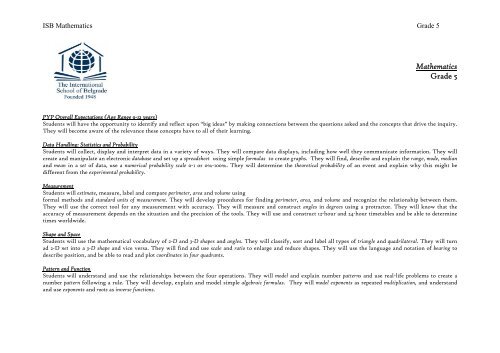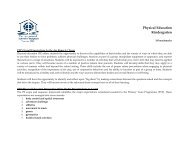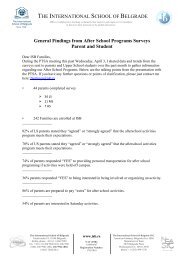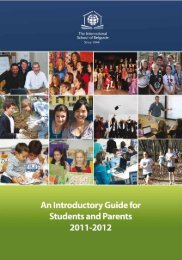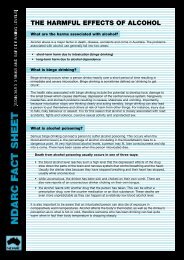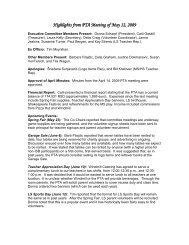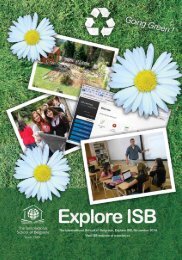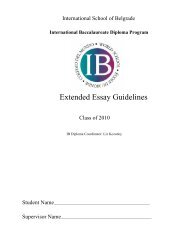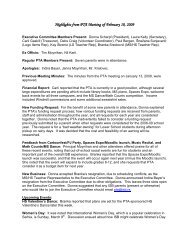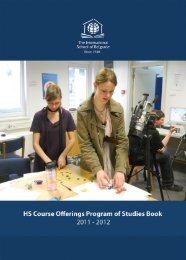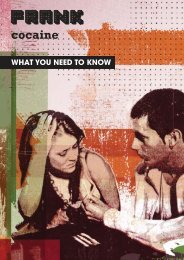Mathematics - Grade 5.pdf
Mathematics - Grade 5.pdf
Mathematics - Grade 5.pdf
Create successful ePaper yourself
Turn your PDF publications into a flip-book with our unique Google optimized e-Paper software.
ISB <strong>Mathematics</strong> <strong>Grade</strong> 5<br />
<strong>Mathematics</strong><br />
<strong>Grade</strong> 5<br />
PYP Overall Expectations (Age Range 9-12 years)<br />
Students will have the opportunity to identify and reflect upon “big ideas” by making connections between the questions asked and the concepts that drive the inquiry.<br />
They will become aware of the relevance these concepts have to all of their learning.<br />
Data Handling: Statistics and Probability<br />
Students will collect, display and interpret data in a variety of ways. They will compare data displays, including how well they communicate information. They will<br />
create and manipulate an electronic database and set up a spreadsheet using simple formulas to create graphs. They will find, describe and explain the range, mode, median<br />
and mean in a set of data, use a numerical probability scale 0-1 or 0%-100%. They will determine the theoretical probability of an event and explain why this might be<br />
different from the experimental probability.<br />
Measurement<br />
Students will estimate, measure, label and compare perimeter, area and volume using<br />
formal methods and standard units of measurement. They will develop procedures for finding perimeter, area, and volume and recognize the relationship between them.<br />
They will use the correct tool for any measurement with accuracy. They will measure and construct angles in degrees using a protractor. They will know that the<br />
accuracy of measurement depends on the situation and the precision of the tools. They will use and construct 12-hour and 24-hour timetables and be able to determine<br />
times worldwide.<br />
Shape and Space<br />
Students will use the mathematical vocabulary of 2-D and 3-D shapes and angles. They will classify, sort and label all types of triangle and quadrilateral. They will turn<br />
ad 2-D net into a 3-D shape and vice versa. They will find and use scale and ratio to enlarge and reduce shapes. They will use the language and notation of bearing to<br />
describe position, and be able to read and plot coordinates in four quadrants.<br />
Pattern and Function<br />
Students will understand and use the relationships between the four operations. They will model and explain number patterns and use real-life problems to create a<br />
number pattern following a rule. They will develop, explain and model simple algebraic formulas. They will model exponents as repeated multiplication, and understand<br />
and use exponents and roots as inverse functions.
ISB <strong>Mathematics</strong> <strong>Grade</strong> 5<br />
Number<br />
Students will read, write and model numbers to one million and beyond, extending the base 10 system to the millions and thousandths. They will automatically use<br />
number facts. They will read, write, model, compare and order fractions (including improper fractions and mixed numbers), decimals (to any given place) and percentages.<br />
They will interchange fractions, decimals and percentages. They will add and subtract fractions with related denominators, simplify fractions and explore fractions using a<br />
calculator. They will add and subtract decimals to the thousandths and will model multiplication and division of decimals in the context of money. They will find and use<br />
ratios; read, write and model addition and subtraction of integers; and use exponential notation. They will use and describe multiple strategies to create and solve more<br />
complex problems, reasonably estimating the answers. They will select and defend the most appropriate and efficient method.
ISB <strong>Mathematics</strong> <strong>Grade</strong> 5<br />
PYP<br />
Understands the meaning, uses, and representation<br />
of numbers<br />
Reads and writes whole numbers through billions and<br />
decimal through thousandths using standard base-10<br />
place-value notation; identifies digits and expresses<br />
their values in such numbers.<br />
Uses and explains strategies (e.g., using equivalent<br />
fractions) for solving problems involving percents and<br />
discounts.<br />
Curriculum Examples/Ideas<br />
PYP Understands equivalent names and numbers Curriculum Examples/Ideas<br />
Uses numerical expressions involving all four<br />
operations, parentheses, and exponents to represent<br />
equivalent names for whole numbers, fractions, and<br />
decimals; uses and explains multiplication and division<br />
rules to find equivalent fractions and fractions in<br />
simplest form; converts between fractions and mixed<br />
numbers; converts between fractions, decimals, and<br />
percents; renames numbers written in exponential<br />
notation as repeated-factor expressions (e.g., 2 ^ 3 = 2 * 2<br />
* 2) and in standard notation (e.g., 2 ^ 3 = 8).
ISB <strong>Mathematics</strong> <strong>Grade</strong> 5<br />
PYP Understands common numerical relations Curriculum Examples/Ideas<br />
Orders whole numbers through billions, decimals<br />
through thousandths, mixed sets of decimals and<br />
fractions and signed numbers; uses and justifies<br />
strategies for ordering fractions and mixed numbers such<br />
as area models, benchmark comparisons, and analyses of<br />
numerators and denominators.<br />
Identifies prime and composite numbers; factor<br />
numbers.
ISB <strong>Mathematics</strong> <strong>Grade</strong> 5<br />
PYP Computes accurately Curriculum Examples/Ideas<br />
Chooses, uses, and explains appropriate algorithms for<br />
solving problems and number stories involving the<br />
addition and subtraction of whole numbers, decimals,<br />
and 1- and 2-digit signed numbers.<br />
Knows and applies multiplication facts, related division<br />
facts, and extended facts.<br />
Chooses, uses, and explains appropriate algorithms<br />
(mental and/or paper-and-pencil) for solving problems<br />
and number stories involving the multiplication of<br />
multi-digit whole numbers and decimals and the<br />
division of multi-digit whole numbers (expressing the<br />
remainder as a whole number or fraction as appropriate<br />
to the context of the problem.) and decimals by whole<br />
numbers.<br />
Chooses, uses, and explains algorithms (mental and/or<br />
paper-and-pencil) for solving problems and number<br />
stories involving the addition and subtraction of<br />
fractions and mixed numbers.<br />
Uses and explains strategies (e.g., area model, paperand-pencil<br />
algorithm) for solving problems and number<br />
stories involving the multiplication of fractions and<br />
mixed numbers; uses and explains strategies (e.g.,<br />
diagrams or common-denominator method) for solving<br />
problems and number stories involving the division of<br />
fractions.
ISB <strong>Mathematics</strong> <strong>Grade</strong> 5<br />
PYP Makes reasonable estimates Curriculum Examples/Ideas<br />
Chooses, uses, and explains strategies to estimate<br />
reasonable solutions (ballpark and magnitude<br />
estimates) for whole number and decimal addition,<br />
subtraction, multiplication, and division problems and<br />
fraction and mixed number addition and subtraction<br />
problems.<br />
PYP Understands patterns, relations, and functions Curriculum Examples/Ideas<br />
Creates, describes and extends numerical patterns;<br />
finds, describes, and records rules for patterns and uses<br />
them to solve problems.<br />
Finds and records rules for simple functions (e.g., rates)<br />
involving all four operations; represents simple<br />
functions using words, symbols, tables, and graphs; and<br />
uses those representations or other strategies to solve<br />
problems.
ISB <strong>Mathematics</strong> <strong>Grade</strong> 5<br />
PYP<br />
Represents and analyzes situations and structures<br />
using algebraic symbols<br />
Determines whether number sentences are true or false;<br />
solves open number sentence and explains the solution<br />
strategies used; uses a single variable to write an open<br />
sentence to fit a number story.<br />
Evaluates expressions containing parentheses and<br />
nested parentheses; inserts parentheses and nested<br />
parentheses to make number sentences true; uses and<br />
explains the precedence of multiplication and division<br />
over addition and subtraction.<br />
Explains and applies the basic properties of addition and<br />
multiplication (the Additive and Multiplicative<br />
Identities, the Commutative and Associative Properties<br />
of Addition and Multiplication, and the Distributive<br />
Property of Multiplication over Addition).<br />
Uses a pan-balance model to solve simple equations.<br />
Uses scales to find distances and other measurements;<br />
uses ratios expressed in a variety of ways (e.g., as<br />
words, fractions, percents, and with colons); solves<br />
simple ratio problems (e.g., problems involving ratios of<br />
parts of a set to the whole set).<br />
Curriculum Examples/Ideas
ISB <strong>Mathematics</strong> <strong>Grade</strong> 5<br />
PYP<br />
Understands the units, systems, and processes of<br />
measurement; uses appropriate techniques, tools,<br />
and formulas to determine measurement<br />
Estimates the length of, measures objects, and draws<br />
line segments to the nearest ⅛ inch and millimeter;<br />
estimates the measure of an angle; uses a full-circle or<br />
half-circle protractor to measure and draw angles.<br />
Describes and uses strategies to calculate the perimeter<br />
of a shape and the area of a circle; chooses and uses<br />
appropriate formulas to calculate the areas of rectangles,<br />
parallelograms, and triangles, and to calculate the<br />
volume of a prism; derives pi as the ratio of the<br />
circumference to the diameter of a circle.<br />
Describes relationships among U.S. customary units of<br />
length, among U.S. customary units of capacity, among<br />
metric units of length; identifies equivalent measures of<br />
length in each system and equivalent measures of<br />
capacity in U.S. customary system.<br />
Curriculum Examples/Ideas
ISB <strong>Mathematics</strong> <strong>Grade</strong> 5<br />
PYP<br />
Uses reference frames to locate numbers within a<br />
given context<br />
Uses ordered pairs of numbers to name, locate, and plot<br />
points on the first quadrant of a coordinate grid.<br />
Curriculum Examples/Ideas<br />
PYP<br />
Analyzes characteristics and properties of two- and<br />
three-dimensional geometric shapes<br />
Identifies, describes, compares, names, and draws right,<br />
acute, obtuse, straight, and reflex angles; determines<br />
angle measures by applying properties of sums of angle<br />
measures in triangles and quadrangles.<br />
Describes, compares, and classifies plane and solid<br />
figures using appropriate geometric language; identifies<br />
and models congruent figures and describes their<br />
properties.<br />
Curriculum Examples/Ideas<br />
PYP<br />
Applies transformations and uses symmetry to<br />
analyze mathematical situations<br />
Identifies, describes, and sketches instances of reflection<br />
symmetry, translations, and rotations.<br />
Curriculum Examples/Ideas
ISB <strong>Mathematics</strong> <strong>Grade</strong> 5<br />
PYP<br />
Selects, creates, and uses appropriate graphical<br />
representations of collected or given data<br />
Selects, creates (with reasonable titles, labels, keys,<br />
intervals) and uses a graph (e.g., bar or line) for a given<br />
set of grade-appropriate data.<br />
Curriculum Examples/Ideas<br />
PYP Analyzes and interprets data Curriculum Examples/Ideas<br />
Uses data landmarks (maximum, minimum, range,<br />
median, mode, and mean) and grade-appropriate data<br />
representations to ask and answer questions, draw<br />
conclusions, and make predictions.<br />
PYP<br />
Understands and applies basic concepts of<br />
probability<br />
Predicts the outcomes of simple experiments, tests the<br />
predictions, summarizes the results (including a<br />
comparison of predictions based on theoretical<br />
probability with experimental results), and uses them to<br />
predict future events.<br />
Curriculum Examples/Ideas


